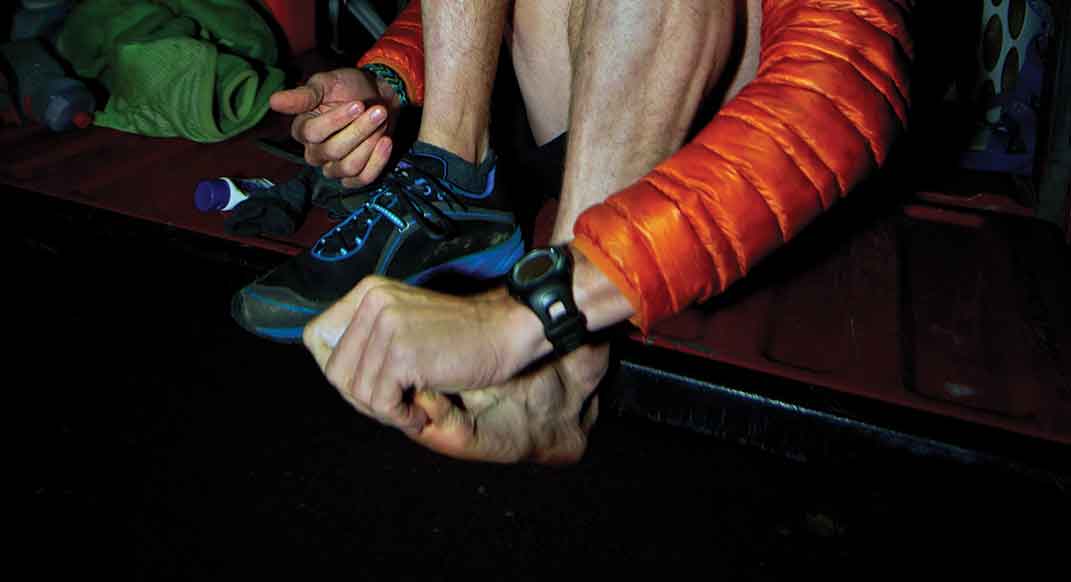Blisters, Bonking and Blackened Toenails

This article originally appeared in the July 2017 issue of Trail Runner magazine.
From engineered nutrition supplements to fancy GPS watches, advances in science and technology have changed the way we run on trails. But technology doesn’t solve everything. Despite high-tech shoes and socks, we still get blisters. No matter how many fancy electrolyte powders we consume, we still bonk and get cramps.
Just as we’ve survived before technology, so, too, can we overcome these common-yet-befuddling race-day ailments through our running form and racing strategy.
“Dead Quads”
Avoiding excessive quadriceps-muscle strain is crucial to maintaining late-race momentum. While conventional wisdom recommends heavy downhill repetition in training to prevent dead quads on race day, there are other, more effective strategies.
Running form: How you use your quads is just as important on uphills as on downhills. Load your hip on both the climbs and the descents—lean your trunk forward without hinging at the waist, and push your butt behind you—to engage your gluteal muscles and save your quads.
Race day: If you find yourself with serious quad pain in the middle of a race, tilt forward (but don’t bend at the waist), to recruit your glutes and unload stress from your quads. Also, at every opportunity, lift the knees, which helps stretch out your quad muscles and aids in forward propulsion.
Blisters and Toenail Pain
We trail runners spend a great deal of time trying to prevent blisters, not to mention the dreaded black toenail. Trail debris is certainly a factor in blister formation, but the key ingredient is friction between your foot and your shoe.
Running form: When you over-stride—with your foot landing significantly in front of your trunk—your body absorbs the landing energy with a braking force, causing the foot to slide within the shoe and sock. Blisters and toenail pain may result.
Run tall and forward so that your foot lands beneath your body, rather than in front of it. Then, try what I call a “pawback”: using your glutes and hamstrings, pull your foot and leg beneath your body just before landing, neutralizing over-striding.
Race day: Should a blister strike mid-race, stop and take the time to perform damage control. Then adjust your stride, focusing on a forward lean and knee lift, and working on the pawback.
Nausea, Vomiting and Bonking
During moderate to high-intensity exercise, the body’s nervous system makes decisions on where to allocate resources. As intensity rises, the body decreases blood flow to the digestive system in favor of more vital systems, such as your brain, and cardiovascular and muscular systems. Impaired digestion is often a result.
If the brain’s internal pacing system (called the Central Governor) decides that your effort is unsustainable, it may try to shut down your stomach altogether, like an emergency brake in a car: a last resort to get you to stop.
Running form (and pacing): In training, balance a large volume of easy running with bouts of controlled, sustainable hard running. If the Central Governor believes your pace is sustainable, it will maintain better blood flow to the gastrointestinal (GI) system.
Another theory, rooted in in osteopathic medicine, says that digestive upset is a nervous-system issue. The nerves responsible for supplying the GI tract live in the upper to middle trunk. With chronic stiffness and rounded posture, these nerves can become hyper-sensitive, causing them to over-fire and prematurely shut down the stomach. Maintaining good posture, both during and after running, may be a powerful arrow in your quiver to prevent a sensitive stomach.
Race day: If you encounter GI distress mid-race, first slow down so that your system will exit the high-intensity self-preservation mode, and provide more blood flow to the stomach. Then, titrate small doses of fuel frequently and on a schedule. As little as a half-sip every five minutes will help get your stomach back on board.
Cramping
Few things are more debilitating than cramping. Conventional wisdom blames cramping on hydration and electrolyte deficits, but subsequent research (well-chronicled in Tim Noakes’ Waterlogged) has shown that water and salt can only mitigate cramps, and mildly at that. Instead, cramping is now known to be a neurological phenomenon.
Running form: Most long-distance trail cramping occurs in the calves, hamstrings, adductors and quads. Coincidentally, these are all secondary muscles that tend to be over-used when the primary movers—the hip and core muscles—get fatigued or under-utilized. An overused-yet-under-stretched muscle is prone to damage, and it is thought that the brain will initiate a cramp response to get you to change: either to stop using the muscle, or to use it differently. A forward trunk lean puts the gluteals in position for a strong push off, and the hip flexors and abdominals in position to drive upward and forward with the hip.
As with nausea and bonking, cramping is a central response to threat. If the brain perceives that what you’re doing is too intense, it will use cramping to slow you down. Balanced and sustainable training will condition the muscles, and also reassure the Central Governor that the intensity and volume of running is safe.
Race day: If cramping develops in the middle of a race, you have no choice but to slow down to reduce the strain on the system. If the cramping is severe, relax and walk as normally as possible, in order to calm the central and peripheral muscle systems. Stopping to stretch may be an option, but be aware: it could make the cramping worse.
When running feels possible, begin at an easy pace, focusing on form. For thigh and lower-leg cramps, including calves, hamstrings and quads, recruit the glutes and abs by leaning forward and lifting the knees.
Joe Uhan has a Master’s Degree in Kinesiology and a Doctorate in Physical Therapy, and is a USATF Level II Certified Coach.